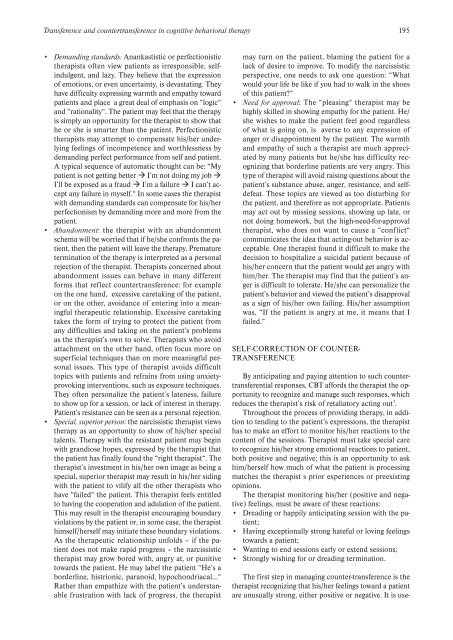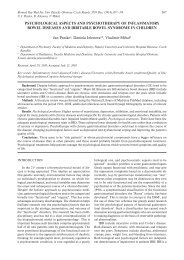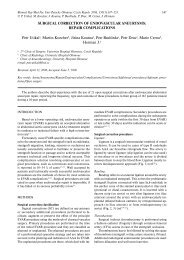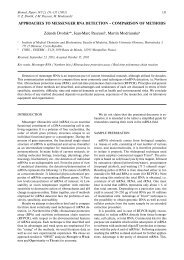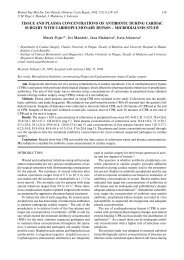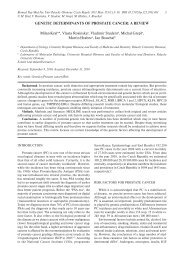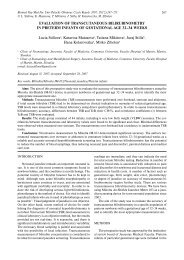Transference and countertransference in cognitive behavioral therapy
Transference and countertransference in cognitive behavioral therapy
Transference and countertransference in cognitive behavioral therapy
You also want an ePaper? Increase the reach of your titles
YUMPU automatically turns print PDFs into web optimized ePapers that Google loves.
<strong>Transference</strong> <strong>and</strong> <strong>countertransference</strong> <strong>in</strong> <strong>cognitive</strong> <strong>behavioral</strong> <strong>therapy</strong>195• Dem<strong>and</strong><strong>in</strong>g st<strong>and</strong>ards: Anankastistic or perfectionistictherapists often view patients as irresponsible, self<strong>in</strong>dulgent,<strong>and</strong> lazy. They believe that the expressionof emotions, or even uncerta<strong>in</strong>ty, is devastat<strong>in</strong>g. Theyhave difficulty express<strong>in</strong>g warmth <strong>and</strong> empathy towardpatients <strong>and</strong> place a great deal of emphasis on “logic“<strong>and</strong> “rationality“. The patient may feel that the <strong>therapy</strong>is simply an opportunity for the therapist to show thathe or she is smarter than the patient. Perfectionistictherapists may attempt to compensate his/her underly<strong>in</strong>gfeel<strong>in</strong>gs of <strong>in</strong>competence <strong>and</strong> worthlessness bydem<strong>and</strong><strong>in</strong>g perfect performance from self <strong>and</strong> patient.A typical sequence of automatic thought can be: “Mypatient is not gett<strong>in</strong>g better I’m not do<strong>in</strong>g my job I’ll be exposed as a fraud I’m a failure I can’t acceptany failure <strong>in</strong> myself.“ In some cases the therapistwith dem<strong>and</strong><strong>in</strong>g st<strong>and</strong>ards can compensate for his/herperfectionism by dem<strong>and</strong><strong>in</strong>g more <strong>and</strong> more from thepatient.• Ab<strong>and</strong>onment: the therapist with an ab<strong>and</strong>onmentschema will be worried that if he/she confronts the patient,then the patient will leave the <strong>therapy</strong>. Prematureterm<strong>in</strong>ation of the <strong>therapy</strong> is <strong>in</strong>terpreted as a personalrejection of the therapist. Therapists concerned aboutab<strong>and</strong>onment issues can behave <strong>in</strong> many differentforms that reflect <strong>countertransference</strong>: for exampleon the one h<strong>and</strong>, excessive caretak<strong>in</strong>g of the patient,or on the other, avoidance of enter<strong>in</strong>g <strong>in</strong>to a mean<strong>in</strong>gfultherapeutic relationship. Excessive caretak<strong>in</strong>gtakes the form of try<strong>in</strong>g to protect the patient fromany difficulties <strong>and</strong> tak<strong>in</strong>g on the patient’s problemsas the therapist’s own to solve. Therapists who avoidattachment on the other h<strong>and</strong>, often focus more onsuperficial techniques than on more mean<strong>in</strong>gful personalissues. This type of therapist avoids difficulttopics with patients <strong>and</strong> refra<strong>in</strong>s from us<strong>in</strong>g anxietyprovok<strong>in</strong>g<strong>in</strong>terventions, such as exposure techniques.They often personalize the patient’s lateness, failureto show up for a session, or lack of <strong>in</strong>terest <strong>in</strong> <strong>therapy</strong>.Patient’s resistance can be seen as a personal rejection.• Special, superior person: the narcissistic therapist views<strong>therapy</strong> as an opportunity to show of his/her specialtalents. Therapy with the resistant patient may beg<strong>in</strong>with gr<strong>and</strong>iose hopes, expressed by the therapist thatthe patient has f<strong>in</strong>ally found the “right therapist“. Thetherapist’s <strong>in</strong>vestment <strong>in</strong> his/her own image as be<strong>in</strong>g aspecial, superior therapist may result <strong>in</strong> his/her sid<strong>in</strong>gwith the patient to vilify all the other therapists whohave “failed“ the patient. This therapist feels entitledto hav<strong>in</strong>g the cooperation <strong>and</strong> adulation of the patient.This may result <strong>in</strong> the therapist encourag<strong>in</strong>g boundaryviolations by the patient or, <strong>in</strong> some case, the therapisthimself/herself may <strong>in</strong>itiate these boundary violations.As the therapeutic relationship unfolds – if the patientdoes not make rapid progress – the narcissistictherapist may grow bored with, angry at, or punitivetowards the patient. He may label the patient “He’s aborderl<strong>in</strong>e, histrionic, paranoid, hypochondriacal...“Rather than empathize with the patient’s understanablefrustration with lack of progress, the therapistmay turn on the patient, blam<strong>in</strong>g the patient for alack of desire to improve. To modify the narcissisticperspective, one needs to ask one question: “Whatwould your life be like if you had to walk <strong>in</strong> the shoesof this patient?“• Need for approval: The “pleas<strong>in</strong>g“ therapist may behighly skilled <strong>in</strong> show<strong>in</strong>g empathy for the patient. He/she wishes to make the patient feel good regardlessof what is go<strong>in</strong>g on, is averse to any expression ofanger or disappo<strong>in</strong>tment by the patient. The warmth<strong>and</strong> empathy of such a therapist are much appreciatedby many patients but he/she has difficulty recogniz<strong>in</strong>gthat borderl<strong>in</strong>e patients are very angry. Thistype of therapist will avoid rais<strong>in</strong>g questions about thepatient’s substance abuse, anger, resistance, <strong>and</strong> selfdefeat.These topics are viewed as too disturb<strong>in</strong>g forthe patient, <strong>and</strong> therefore as not appropriate. Patientsmay act out by miss<strong>in</strong>g sessions, show<strong>in</strong>g up late, ornot do<strong>in</strong>g homework, but the high-need-for-approvaltherapist, who does not want to cause a “conflict“communicates the idea that act<strong>in</strong>g-out behavior is acceptable.One therapist found it difficult to make thedecision to hospitalize a suicidal patient because ofhis/her concern that the patient would get angry withhim/her. The therapist may f<strong>in</strong>d that the patient’s angeris difficult to tolerate. He/she can personalize thepatient’s behavior <strong>and</strong> viewed the patient’s disapprovalas a sign of his/her own fail<strong>in</strong>g. His/her assumptionwas, “If the patient is angry at me, it means that Ifailed.“SELF-CORRECTION OF COUNTER-TRANSFERENCEBy anticipat<strong>in</strong>g <strong>and</strong> pay<strong>in</strong>g attention to such countertransferentialresponses, CBT affords the therapist the opportunityto recognize <strong>and</strong> manage such responses, whichreduces the therapist’s risk of retaliatory act<strong>in</strong>g out 7 .Throughout the process of provid<strong>in</strong>g <strong>therapy</strong>, <strong>in</strong> additionto tend<strong>in</strong>g to the patient’s expressions, the therapisthas to make an effort to monitor his/her reactions to thecontent of the sessions. Therapist must take special careto recognize his/her strong emotional reactions to patient,both positive <strong>and</strong> negative; this is an opportunity to askhim/herself how much of what the patient is process<strong>in</strong>gmatches the therapist s prior experiences or preexist<strong>in</strong>gop<strong>in</strong>ions.The therapist monitor<strong>in</strong>g his/her (positive <strong>and</strong> negative)feel<strong>in</strong>gs, must be aware of these reactions:• Dread<strong>in</strong>g or happily anticipat<strong>in</strong>g session with the patient;• Hav<strong>in</strong>g exceptionally strong hateful or lov<strong>in</strong>g feel<strong>in</strong>gstowards a patient;• Want<strong>in</strong>g to end sessions early or extend sessions;• Strongly wish<strong>in</strong>g for or dread<strong>in</strong>g term<strong>in</strong>ation.The first step <strong>in</strong> manag<strong>in</strong>g counter-transference is thetherapist recogniz<strong>in</strong>g that his/her feel<strong>in</strong>gs toward a patientare unusually strong, either positive or negative. It is use-


